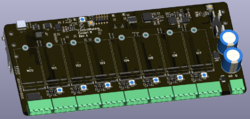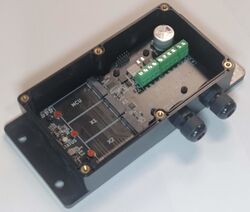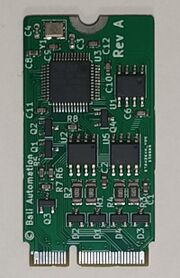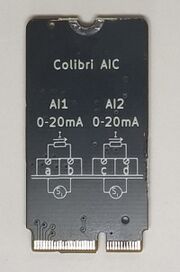Colibri
Colibri is a low-cost automation system, primarily intended for building automation, home automation, energy supervision, agriculture supervision and similar systems. Main features beside costs are;
- Flexible I/O system, via Expansion Cards in M.2 Key E sockets. Many types already developed.
- Power supply of 9-36 Volt, either AC or DC (some expansion cards won't work with DC supply, and some not with AC supply)
- Each I/O slot can be powered-up/down individually from the MCU.
- Each I/O slot is addressable individually.
- Each expansion module has an 8kB EEPROM with calibration parameters and a Forth program for the MCU module.
- Some expansion modules have on-board secondary processors for time-critical or other reasons, for instance RS-485 communication, pulse counting and PID regulator.
Carrier Boards
- Colibri-3 using LoraWAN for communications and 2 I/O expansion slots.
- Planned; Colibri-8 is like the Colibri-3, but with 7 I/O expansion slots.
- Planned; Colibri-8pi is like the Colibri-8 but with a full-fledged Raspberry Pi Compute Module 5. 1 Colibri MCU slot and 7 expansion slots,
- Planned; Colibri-16pi is like the Colibri-8pi, but with 15 expansion slots rather than 7.
MCU Modules
There is a choice, and more will follow;
- Colibri MCU1 - MCU module with a STM32WLE5, 256kB Flash, 64kB RAM, on-chip LoRa and LoraWAN protocol available in STM32CubeMX.
- Colibri MCU2 - MCU module with a STM32H562RG, 1024kB Flash, 640kB RAM and a 16MB external flash memory.
- Colibri MCU3 - MCU module with a STM32F401RC, 256kB Flash, 64kB RAM and a 16MB external flash memory.
Expansion Modules
The Colibri system is based around the M.2 connector and a non-standard bus for I2C and SPI communications. Each expansion board has a EEPROM memory available to identify which module is present in each expansion slot. Furthermore, there is a Colibri Forth program located in the eeprom that contains the functionality of the module, executed in the MCU module. This allows for future expansion modules without requiring the upgrade of the MCU module.
NOTE; Colibri Forth is only available/supported for the Colibri MCU1 and MCU3 at the moment. Porting to other MCUs may or may not happen in the future.
Form Factor
Colibri expansion boards are 22x42mm and has an edge connector called M.2 Key E, but it doesn't follow the M.2 specification for Key E. The distance between the expansion slots are specified to 23.5mm, theoretically making it possible for multi-slot expansion modules (none are planned).
WARNING!!! Do NOT plug Colibri expansion boards into other equipment. Do NOT plug any M.2 card into a Colibri system, unless that card/board is specifically made for Colibri.
Boards
| Name | Type | Description | Status |
|---|---|---|---|
| Colibri 3a | Colibri Carrier | Minimal Colibri Host with 2 expansion cards. MCU slot is to be populated with any of the MCU variants available. | Prototyping |
| Colibri 1dp | Colibri Carrier | Minimal Colibri Host with a single MCU slot and 0-500Pa air pressure sensor. | Prototyping |
| Colibri MCU1 | Host MCU | MCU module with a STM32WLE5CC, for LoraWAN applications. | Prototyping |
| Colibri MCU2 | Host MCU | MCU module with a STM32H562RG and a 16MB flash memory. | Prototyping |
| Colibri MCU3 | Host MCU | MCU module with a STM32F401RC and a 16MB flash memory. | Prototyping |
| M.2 E Breakout | M.2 breakout board | Generic breakout board for M.2 E key boards. | Available for pre-orders |
| Colibri AIC | I/O Expansion | Two analog 0-20mA inputs | Prototyping |
| Colibri AIV | I/O Expansion | Two analog 0-10V inputs | Prototyping |
| Colibri AQV | I/O Expansion | Two analog 0-10V outputs | Prototyping |
| Colibri DII | I/O Expansion | Two ISOLATED digital inputs, for state, counter, pulsewidth measurement. On-board STM32F030 for ability to count very fast pulses and high accuracy PWM measurements. | Prototyping |
| Colibri DIO1 | I/O Expansion | IEC 61131-2 compliant, 4-channels digital inputs and outputs. | Prototyping |
| Colibri DIU | I/O Expansion | Four digital inputs, for state, counter, pulsewidth measurement. On-board STM32F030 for ability to count very fast pulses and high accuracy PWM measurements. | Prototyping |
| Colibri DP1 | I/O Expansion | A 0-500Pa air pressure sensor mounted on I/O module. | Prototyping |
| Colibri FET | I/O Expansion | Four digital outputs, FET outputs sinking to GND. Max 1 Amp per channel. | Prototyping |
| Colibri PID1 | I/O Expansion | PID regulator, with a PT1000 input and a 0-10V analog output. On-board STM32F030 for host-independent operation. | Prototyping |
| Colibri Pt1000 | I/O Expansion | Two PT1000 temperature sensor inputs. | Prototyping |
| Colibri RS485I | I/O Expansion | Isolated RS-485 port. On-board STM32G431KB to implement protocols, such as Modbus RTU. | Prototyping |
| Colibri RS485U | I/O Expansion | Two non-isolated RS-485 ports. On-board STM32F030 implementing Modbus protocol, either as master or slave device. | Prototyping |
| Colibri SSR | I/O Expansion | Two Solid State Relays, ON/OFF. | Prototyping |
| Colibri TRIAC1 | I/O Expansion | Four Triac outputs, driving 24V AC. | Prototyping |
Planned Boards
| Name | Type | Description | Status | |
|---|---|---|---|---|
| Colibri-8 | Colibri Carrier | Colibri carrier board with Colibri MCU slot and 7 Colibri expansion cards. | Planned | |
| Colibri-8pi | Colibri Carrier | Colibri carrier board with Raspberry Pi CM5, Colibri MCU slot, 7 Colibri expansion cards, two Ethernet ports, 3 USB ports and SDcard connector. | Planned | |
| Colibri-16pi | Colibri Carrier | Colibri carrier board with Raspberry Pi CM5, Colibri MCU slot, 15 Colibri expansion cards, two Ethernet ports, 3 USB ports and SDcard connector. | Planned |
License
All Schematics are licensed with the GPLv3, meaning that you are free to make your own designs or manufacture devices using these. We expect that if you derive new design, that you publish these, preferably on this website.
The software will also be published with GPLv3, when something is workable.



